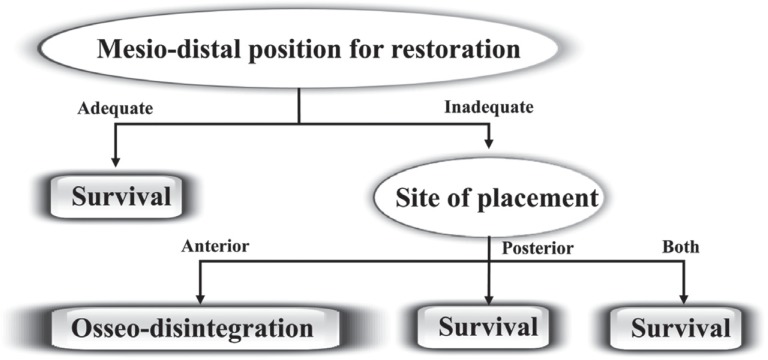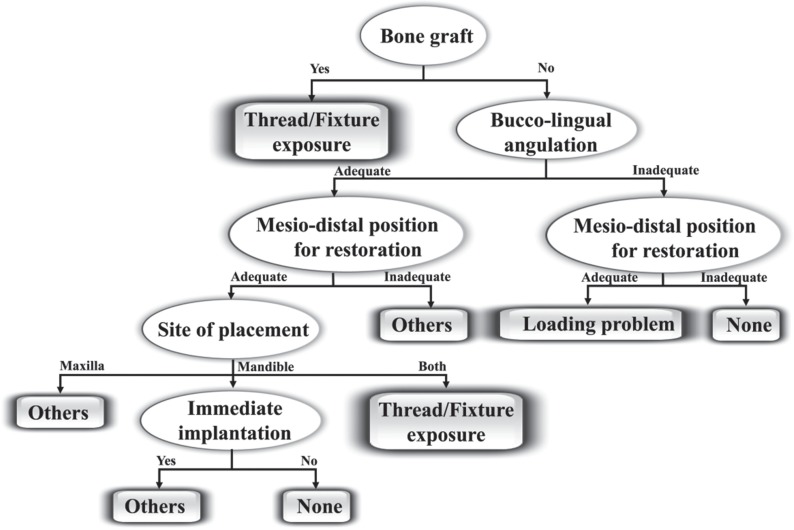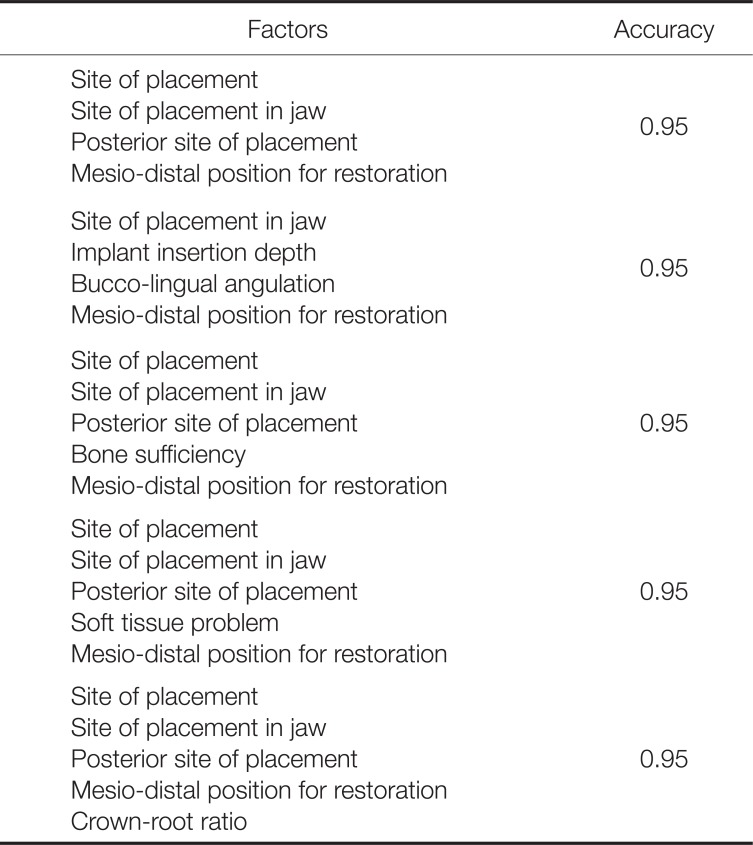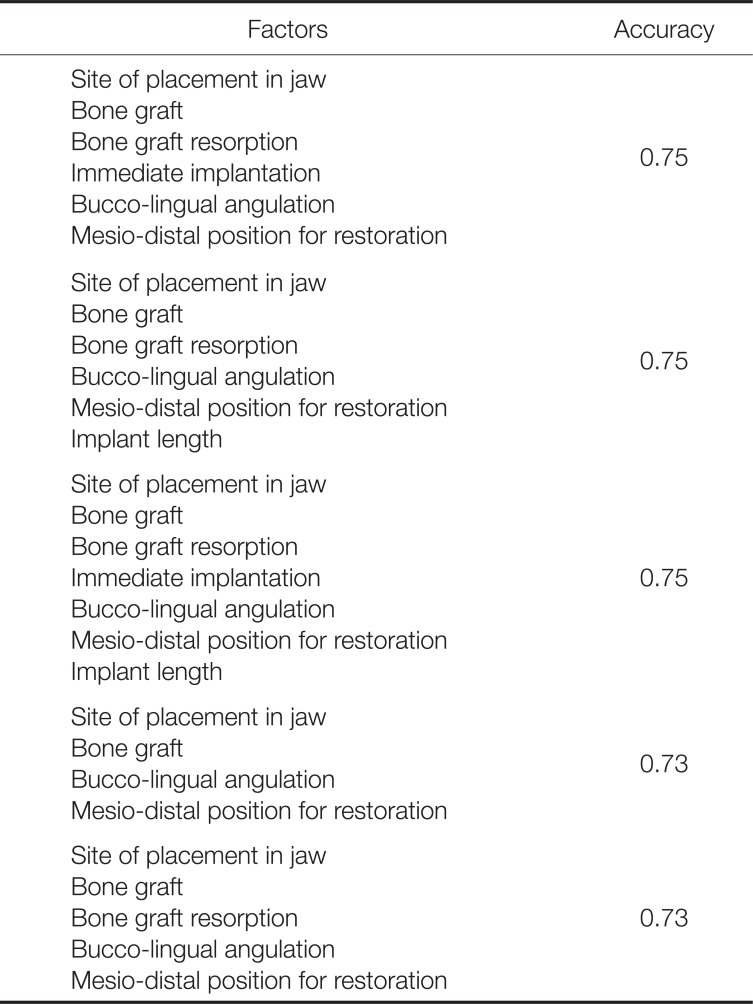1. Academy of Osseointegration. 2010 Guidelines of the Academy of Osseointegration for the provision of dental implants and associated patient care. Int J Oral Maxillofac Implants. 2010; 25:620–627. PMID:
20653117.
2. Kohner JS. Implant team: problems and solutions with osseointegrated implants. Pract Periodontics Aesthet Dent. 1992; 4:27–32.
3. Garber DA, Belser UC. Restoration-driven implant placement with restoration-generated site development. Compend Contin Educ Dent. 1995; 16:796798–802. 804PMID:
8620398.
4. Bryant SR. The effects of age, jaw site, and bone condition on oral implant outcomes. Int J Prosthodont. 1998; 11:470–490. PMID:
9922739.
5. Omran MT, Miley DD, McLeod DE, Garcia MN. Retrospective assessment of survival rate for short endosseous dental implants. Implant Dent. 2015; 24:185–191. PMID:
25706268.

6. Tolstunov L. Implant zones of the jaws: implant location and related success rate. J Oral Implantol. 2007; 33:211–220. PMID:
17912962.

7. Walton JN, MacEntee MI. Choosing or refusing oral implants: a prospective study of edentulous volunteers for a clinical trial. Int J Prosthodont. 2005; 18:483–488. PMID:
16335167.

8. Furey TS, Cristianini N, Duffy N, Bednarski DW, Schummer M, Haussler D. Support vector machine classification and validation of cancer tissue samples using microarray expression data. Bioinformatics. 2000; 16:906–914. PMID:
11120680.

9. Mitchell TM. Machine Learning. New York: McGraw-Hill;1997. p. 414.
10. Gambhir SS, Hoh CK, Phelps ME, Madar I, Maddahi J. Decision tree sensitivity analysis for cost-effectiveness of FDG-PET in the staging and management of non-small-cell lung carcinoma. J Nucl Med. 1996; 37:1428–1436. PMID:
8790186.
11. Nakano Y, Takeshita T, Kamio N, Shiota S, Shibata Y, Suzuki N, Yoneda M, Hirofuji T, Yamashita Y. Supervised machine learning-based classification of oral malodor based on the microbiota in saliva samples. Artif Intell Med. 2014; 60:97–101. PMID:
24439218.

12. Ward JJ, McGuffin LJ, Buxton BF, Jones DT. Secondary structure prediction with support vector machines. Bioinformatics. 2003; 19:1650–1655. PMID:
12967961.

13. Chen J, Xing Y, Xi G, Chen J, Yi J, Zhao D, Wang J. A comparison of four data mining models: Bayes, neural network, SVM and decision trees in identifying syndromes in coronary heart disease. Advances in Neural Networks-ISNN 2007. Springer;2007. p. 1274–1279.
14. Bullinger D, Fröhlich H, Klaus F, Neubauer H, Frickenschmidt A, Henneges C, Zell A, Laufer S, Gleiter CH, Liebich H, Kammerer B. Bioinformatical evaluation of modified nucleosides as biomedical markers in diagnosis of breast cancer. Anal Chim Acta. 2008; 618:29–34. PMID:
18501242.

15. Fung G, Stoeckel J. SVM feature selection for classification of SPECT images of Alzheimer's disease using spatial information. Knowl Inf Syst. 2007; 11:243–258.

16. Son YJ, Kim HG, Kim EH, Choi S, Lee SK. Application of support vector machine for prediction of medication adherence in heart failure patients. Healthc Inform Res. 2010; 16:253–259. PMID:
21818444.

17. Hwang D, Wang HL. Medical contraindications to implant therapy: part I: absolute contraindications. Implant Dent. 2006; 15:353–360. PMID:
17172952.

18. Hwang D, Wang HL. Medical contraindications to implant therapy: Part II: Relative contraindications. Implant Dent. 2007; 16:13–23. PMID:
17356368.

19. Michalski RSE, Carbonell JGE, Mitchell TME. Machine learning: an artificial intelligence approach. New York: Springer-Verlag;1984.
20. Samuel AL. Some studies in machine learning using the game of checkers. IBM J Res Dev. 2000; 44:206–226.

21. Freitag D. Machine learning for information extraction in informal domains. Mach Learn. 2000; 39:169–202.
22. Sebastiani F. Machine learning in automated text categorization. Acm Comput Surv. 2002; 34:1–47.

23. Ivanoff CJ, Sennerby L, Johansson C, Rangert B, Lekholm U. Influence of implant diameters on the integration of screw implants. An experimental study in rabbits. Int J Oral Maxillofac Surg. 1997; 26:141–148. PMID:
9151173.
24. Winkler S, Morris HF, Ochi S. Implant survival to 36 months as related to length and diameter. Ann Periodontol. 2000; 5:22–31. PMID:
11885179.

25. Lin S, Shi S, LeGeros RZ, LeGeros JP. Three-dimensional finite element analyses of four designs of a high-strength silicon nitride implant. Implant Dent. 2000; 9:53–60. PMID:
11307234.

26. Hermann JS, Cochran DL, Nummikoski PV, Buser D. Crestal bone changes around titanium implants. A radiographic evaluation of unloaded nonsubmerged and submerged implants in the canine mandible. J Periodontol. 1997; 68:1117–1130. PMID:
9407406.

27. Tarnow DP, Cho SC, Wallace SS. The effect of inter-implant distance on the height of inter-implant bone crest. J Periodontol. 2000; 71:546–549. PMID:
10807116.












 PDF
PDF ePub
ePub Citation
Citation Print
Print



 XML Download
XML Download